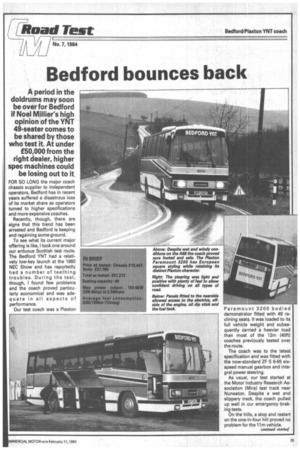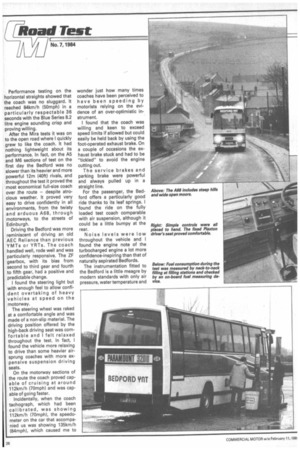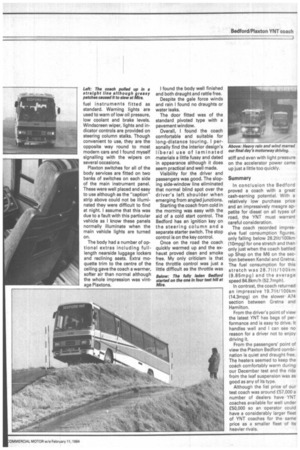Bedford bounces back
Page 27

Page 28

Page 29

If you've noticed an error in this article please click here to report it so we can fix it.
A period in the doldrums may soon be over for Bedford if Noel Millier's high opinion of the YNT 49-seater comes to be shared by those who test it. At under £50,000 from the right dealer, higher spec machines could be losing out to it
FOR SO LONG the major coach chassis supplier to independent operators, Bedford has in recent years suffered a disastrous loss of its market share as operators turned to higher specifications and more expensive coaches.
Recently, though, there are signs that this trend has been arrested and Bedford is keeping and regaining some ground.
To see what its current major offering is like, I took one around our arduous Scottish test route. The Bedford YNT had a relatively low-key launch at the 1980 NEC Show and has reportedly had a number of teething troubles. During the test, though, I found few problems and the coach proved particularly economical and was adequate in all aspects of performance.
Our test coach was a Plaxton Paramount 3200 bodied demonstrator fitted with 49 reclining seats. It was loaded to its full vehicle weight and subsequently carried a heavier load than most of the 12m (40ft) coaches previously tested over the route.
The coach was to the latest specification and was fitted with the now-standard ZF S 6-65 sixspeed manual gearbox and integral power steering.
As usual, our test started at the Motor Industry Research Association (Mira) test track near Nuneaton. Despite a wet and slippery track, the coach pulled up well in our emergency braking tests.
On the hills, a stop and restart on the one-in-four hill proved no problem for the llm vehicle. Performance testing on the horizontal straights showed that the coach was no sluggard. It reached 84km/h (50mph) in a particularly respectable 36 seconds with the Blue Series 8.2 litre engine sounding crisp and proving willing.
After the Mira tests it was on to the open road where I quickly grew to like the coach. It had nothing lightweight about its performance. In fact, on the A5 and M6 sections of test on the first day the Bedford was no slower than its heavier and more powerful 12m (40ft) rivals, and throughout the test it proved the most economical full-size coach over the route — despite atro cious weather. It proved very easy to drive confidently in all environments, from the twisty and arduous A68, through motorways, to the streets of Edinburgh.
Driving the Bedford was more reminiscent of driving an old AEC Reliance than previous YMTs or YRTs. The coach handled well, rode well and was particularly responsive. The ZF gearbox, with its bias from second to third gear and fourth to fifth gear, had a positive and predictable change.
I found the steering light but with enough feel to allow confi dent overtaking of heavy vehicles at speed on the motorway.
The steering wheel was raked at a comfortable angle and was made of a non-slip material. The driving position offered by the high-back driving seat was com fortable and I felt relaxed throughout the test. In fact, I found the vehicle more relaxing to drive than some heavier airsprung coaches with more expensive suspension driving seats.
On the motorway sections of the route the coach proved cap able of cruising at around 112km/h (70mph) and was capable of going faster.
Incidentally, when the coach tachograph, which had been calibrated, was showing 112km/h (70mph), the speedometer on the car that accompa nied us was showing 135km/h (84mph), which caused me to wonder just how many times coaches have been perceived to have been speeding by motorists relying on the evidence of an over-optimistic instrument.
I found that the coach was willing and keen to exceed speed limits if allowed but could easily be held back by using the foot-operated exhaust brake. On a couple of occasions the exhaust brake stuck and had to be "tickled" to avoid the engine cutting out.
The service brakes and parking brake were powerful and always pulled up in a straight line.
For the passenger, the Bedford offers a particularly good ride thanks to its leaf springs. I found the ride on the fully loaded test coach comparable with air suspension, although it could be a little bumpy at the rear.
Noise levels were low throughout the vehicle and I found the engine note of the turbocharged engine a lot more confidence-inspiring than that of naturally aspirated Bedfords.
The instrumentation fitted to the Bedford is a little meagre by modern standards with only air pressure, water temperature and fuel instruments fitted as standard. Warning lights are used to warn of low oil pressure, low coolant and brake levels. Windscreen wiper, lights and indicator controls are provided on steering column stalks. Though convenient to use, they are the opposite way round to most modern cars and I found myself signalling with the wipers on several occasions.
Plaxton switches for all of the body services are fitted on two banks of switches on each side of the main instrument panel. These were well placed and easy to use although as the "caption" strip above could not be illuminated they were difficult to find at night. I assume that this was due to a fault with this particular vehicle as I know these panels normally illuminate when the main vehicle lights are turned on.
The body had a number of optional extras including fulllength nearside luggage lockers and reclining seats. Extra moquette trim to the centre of the ceiling gave the coach a warmer, softer air than normal although the whole impression was vintage Plaxtons. I found the body well finished and both draught and rattle free.
Despite the gale force winds and rain I found no draughts or water leaks.
The door fitted was of the standard pivoted type with a pavement window.
Overall, I found the coach comfortable and suitable for long-distance touring. I personally find the interior design's liberal use of laminated materials a little fussy and dated in appearance although it does seem practical and well made.
Visibility for the driver and passengers was good. The sloping side-window line eliminated that normal blind spot over the driver's left shoulder when emerging from angled junctions.
Starting the coach from cold in the morning was easy with the aid of a cold start control. The Bedford has an ignition key on the steering column and a separate starter switch. The stop control is on the key control.
Once on the road the coach quickly warmed up and the exhaust proved clean and smoke free. My only criticism is that fine throttle control was just a little difficult as the throttle was stiff and even with light pressure on the accelerator power came up just a little too quickly.
Summary
In conclusion the Bedford proved a coach with a great cash-earning potential. With a relatively low purchase price and an impressively meagre appetite for diesel on all types of road, the YNT must warrant careful consideration.
The coach recorded impressive fuel consumption figures, only falling below 28.21it/100km (10mpg) for one stretch and then only just when the coach battled up Shap on the M6 on the section between Kendal and Gretna. The fuel consumption for this stretch was 28.7 lit/1 0 Okm (9.85mpg) and the average speed 84.8km/h (52.7mph).
In contrast, the coach returned an impressive 19.71it/100km (14.3mpg) on the slower A74 section between Gretna and Hamilton.
From the driver's point of view the latest YNT has bags of performance and is easy to drive. It handles well and I can see no reason for a driver not to enjoy driving it.
From the passengers' point of view the Plaxton Bedford combination is quiet and draught free. The heaters seemed to keep the coach comfortably warm during our December test and the ride from the leaf suspension was as good as any of its type.
Although the list price of our test coach was around £57,000 a number of dealers have YNT coaches available for well under £50,000 so an operator could have a considerably larger fleet of YNT coaches for the same price as a smaller fleet of its heavier rivals.
















































































